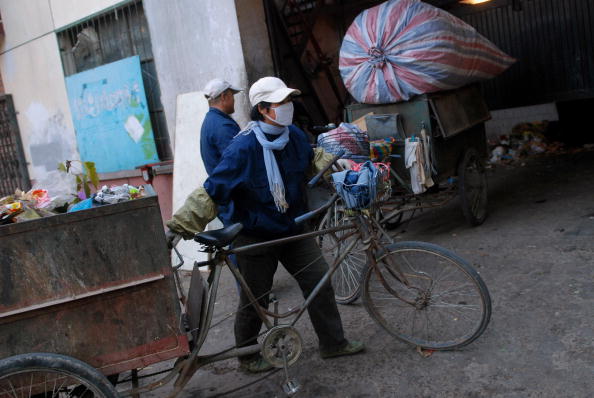India China Reflections – Pt. II
In my first post reflecting on my time in India and China I had started doing a chronology of my travels. But reading back through that post now it seems like there is just too much to cover in bringing things up to date. So rather than rehashing what I did over the past 1.5 months, I’d prefer to do more of a real comparison based on my travels.
I’m not sure that there is really a good place to start when undertaking such an endeavor, but since I’ve always been a fan of list, here’s my short India-China comparison list, highlighting both similarities and differences from my travels:
1) Food
As anyone who knows my might have guessed, food is always at the top of my list, and this time is no different. I can definitely say that one of my favorite things about living in China for a short time was the food, and this is doubly true for Kunming, as it is home to so many diverse ethnic communities, each with their own style of cooking. So with a few exceptions, I felt like we were always trying new foods while in China. And even if we had the same ingredients, there was no guarantee that they would be prepared or taste even remotely similar. I think one of my favorites–which I would not have guessed from the outset–was the Salt and Pepper Shrimp, which I have since learned was originally a Cantonese dish. The versions they make in Kunming did not have any of the additions like those given in the recipe link above–it was just a big plate of shrimp with a bowl of extra salt–but in my opinion it was already plenty salty. Here’s a shot of what this dish looked like in a Kunming restaurant.
Yet on the flip side, I was wholly and consistently disappointed with the food in India, with few exceptions. I’m not sure why, but it seemed that every meal consisted of some variation of curry chicken with rice and roti. And while I don’t have anything against curry chicken, rice or roti on their own, eating this same meal day in and day out got old very quickly.
The few exceptions to the overall disappointing Indian culinary experience were the Bengali mustard fish, or fish paturi, the butter nan at one or two places, and a mutton boti kebab I had at one of the Muslim restaurants in Kolkata. Now just to be clear it’s not the the food was always bad–although there were a few cases–it was more that I felt like i was eating the same basic dish over and over with slight variations, and at some point the taste of curry and chicken and roti just became overwhelming and completely lost all appeal. Something about the indiscriminate use of mustard seed oil and curry, with no thought at all to the final tasty, started to gnaw at my soul.
Now in fairness I was eating from a fairly limited range of India cuisine, mostly those from West Bengal to eastern Rajasthan. We did have a few South India meals, mostly Keralan, which were a nice change, but too infrequent to break the monotony. And I had many, many meals not in local restaurants but in our guest house, so it’s perhaps unfair to expect some run of the mill hotel boys to be exceptional Indian chefs. But also, the chef in me was literally going mad by the end of the trip.
The other food oddity for a country that tends to divide it cuisine into “veg” and “non-veg” was the more or less total absence of vegetables in the Indian cuisine we had. No joke, I really started to think the Indians don’t know what green vegetables are, and I was not alone in this feeling.
Besides potatoes, onions and peas–which I no longer considered vegetables after they were done watering them down into the staple dall paste or curry soup that was at nearly every meal–I ate very few vegetables while in India–which I am still at a loss to fully understand, since India is supposed to be known for its amazing vegetable cuisines!!!
A cauliflower once in a while, a few carrots and green peppers here and there, some terrible okra dishes, and the signature palak paneer–which is supposed to be mostly spinach but you would never know from the overwhelming curry flavor that most places drowned it in–constituted the bulk of my “veg” diet. When we did have any kind of mixed vegetables, you could tell they were freeze dried and had absolutely no flavor beyond mushy curry. I still don’t understand how Hindu vegetarians can survive on this diet?
Now that I have returned to NY I will try my hand at redeeming some of the India cuisine that I know I would otherwise like given a different set of circumstances. But there is no doubt I am already missing the Chinese cuisine. Now it’s time to invest in a real wok and bamboo steamer!
2) Urban Life
This is not a comparison I could have made just 5 years ago, prior to moving to New York. But having lived here in one of the biggest metropolis in the world, I have a much richer and more nuanced perspective on urban life and the city.
But even saying that, the urban landscape of China and India are altogether different from that of NY, and I would hazard to guess, anywhere else in the US. Even within the two countries, there was a great deal of variation in what constitutes “urban,” say for example between Beijing and Kunming, or Kolkata and Delhi. Yet for some odd reason, neither city felt immensely bigger than New York, which had been my expectation for both Beijing and Delhi. Yet walking on the streets of either city, I never got the feeling there was an overwhelming number of people. If anything, it was the car traffic in India that felt the most “urban” to me, and on an entirely different level than anything I saw in China.
Unless you’ve been in urban India, it’s hard to imagine what the street traffic is like, and even coming from NY–which I have always thought was a traffic nightmare–pales in comparison. Between the absolute clusterfuck that is driving in India to the complete absence of any traffic rules being followed–with lights at major intersections being the only real exception. For you NYers, imagine the 3-4 lanes of traffic on the BQE suddenly turned into 5 1/2 lanes with no attention at all to “lanes”, add in the incessant and deafening sound of perpetual honking, and you might, might, just start to get a sense of what Indian urban life is like. Or you could just listen this short clip from Calcutta street traffic I recorded to get a sense of what I mean.
The vehicle congestion was not unique to India, although it is absolutely way more of a clusterfuck in India. Kunming was interesting in that the bulk of the traffic we ran into on a day-to-day basis was still bicycles and motor scooters–which in Kunming have almost become the single most dominant mode of transportation, especially for young people. And since Kunming is a university town, with lots of young people, we saw a plethora of these bikes.
In fact, the “chirp chirp” of their electronic security systems being turned on and off along the street became an almost routine background noise. At first it seemed loud and annoying, but after a few weeks you adjusted to it, and I actually found myself missing this rather minor sound annoyance once I was in India and exposed to the daily whiplash of raw noises.
I also found China far more pedestrian friendly, even if it has its own traffic issues. The sidewalks were generally wide and even, and where there were no sidewalks the streets had enough pedestrian traffic to make walking quite easy. This was not at all the case in India, at least where we were staying, as nearly every sidewalk was jam packed with street cart and vendors, or else there was no sidewalk at all, and so you had the incessant sound of cars honking at every person even marginally in the street as they drove past. In fact, I am convinced that your average Indian driver is incapable of driving without incessant honking, or at least those that have spent any time in the big cities driving.
Which brings me to the other interesting comparison–taxis and private transportation. Both countries have them, but in India the for-hire cars seem to dominate everything. With a few exceptions, the bulk of the vehicle traffic in India is not individual drivers but rather taxis/buses/private cars. Even the faculty we worked with in India never drove themselves anywhere, but always had hired cars driving them everywhere.
The times I did see what looked like private drivers in their cars, they inevitable seemed to be fancier cars with young business-type men behind the wheel. And to the best of my knowledge I never once saw a woman driving a car in Kolkata or Delhi. I know women do drive in India, yet somehow I missed them entirely during my travels–which now that I think about it seems quite odd, but that is an entirely different matter for another time.
The other big difference in terms of the urban landscape that stood out is waste management, both between the US and India-China, and between India and China. It’s no surprise to anyone that the average Indian or Chinese street is considered “dirty” from a middle-class American or European perspective. And in a certain sense this is true. You don’t see the same “trash bicycles” like in Kunming, or the open pits stretching for miles, like you do in India. But it’s not that there is a better solution that the Americans or Europeans have come up with to solve this age-old conundrum.
If anything, the “West” generally speaking has solved the problem by sweeping it under the proverbial rug, whereas in India and China–partly due to the sheer size of their populations–does not have this luxury, and so is more open–if you will–with their garbage. A good example was in Kunming, where every day at least 1-2 times, and probably more, a guy would come around on a large 3-wheeled bike with what looked like a small roll-of trash bin collecting garbage from the local businesses and shops. Although I did not think to get a photo, here’s an example of what I am talking about from Beijing.
Since I don’t know much about how China handles their solid waste, other than some minor details like most of it still gets buried underground like here in the US, I can only speculate about the source of these differences. In China it was common to see two trash bins, one labelled organics and one other waste, or occasionally also a metal or paper bin–mostly depended on what city and where in the city you were. The bicycle trash collector would then ferry their goods to a few select destinations around the city and drop off their goods. I didn’t ever get a good look inside these drop-off centers, but from the few glimpses I did get it appeared like they were doing some second stage sorting of the dumped trash, and from there probably sending it off to a larger facility.
In India, it was an entirely different story, and it seemed like any even marginally abandoned space was a potential trash dump, and this included every sidewalk with houses above it. At first you might miss it, but there is a quite robust trash sorting and repurposing scheme that takes place in India, or at least in the bigger cities with numerous slums. From what I saw, the process seemed to work something like this:
tier 1) middle and upper class homes and businesses throw out their trash, either on the street in piles or occasionally in some more organized fashion
tier 2) groups of people, oftentimes women with several young kids from what I saw, then come and pick through the piles for anything or marginal value, especially metals, plastics and other raw materials.
tier 3) whatever is left over after the tier 2 collectors gets collected and taken to neighborhood dumping ground, which act as some sort of mini garbage dump for the surrounding area. From here another set of trash pickers–or what they call in some of the slums the “rag pickers,” then go through this end trash dump another time, looking for anything that might have been missed by earlier pickers, or which came straight to these larger trash caches.
tier 4) once the tier 2 and 3 groups have sorted and pulled out anything of value, these items are cleaned to varying degrees, collected in bulk, and then taken to be sold to the trash middle-men, who in turn take these bulk collections, pay a certain amount per kilo, and then turn around and sell to scrap dealers for what I imagine is a pretty penny, from the little literature I have read on this process.
You can see a good example of this final stage, between the refuge dump and the selling to the middle man, from the Tiljala bustee slum on the eastern outskirts of Kolkata, where we visited several times during our stay there.
So in one sense the trash problem is not all that different between the US, India and China. We both have growing populations and no solution for our trash. But whereas in the US we have perfected the art of trash hiding and denial, in India and China they seem to be taking a more straightforward, in your face approach, not hiding the trash per se, but simply relocating it to designated areas for additional treatment. In that sense, it’s not all that different from how we do it in the US, but on the surface it makes the level of trash more obvious, at least to an outsider not used to the local norms.
That’s it for now kids. There is plenty more to write about, but that will have to wait for another update. Until next time…eat your greens.
###






